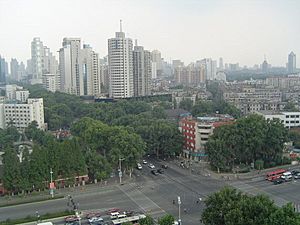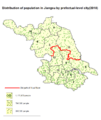Jiangsu facts for kids
Quick facts for kids
Jiangsu Province
江苏省
|
|
|---|---|
| Name transcription(s) | |
| • Chinese | 江苏省 (Jiāngsū Shěng) |
| • Abbreviation | JS / 苏 (pinyin: Sū) |
| • Wu | Kaonsu San |

Map showing the location of Jiangsu Province
|
|
| Named for | 江 Jiangning (now Nanjing) 苏 Suzhou |
| Capital (and largest city) |
Nanjing |
| Divisions | 13 prefectures, 106 counties, 1488 townships |
| Area | |
| • Total | 102,600 km2 (39,600 sq mi) |
| Area rank | 25th |
| Highest elevation | 625 m (2,051 ft) |
| Population
(2015)
|
|
| • Total | 79,800,000 |
| • Rank | 5th |
| • Density | 777.8/km2 (2,014.4/sq mi) |
| • Density rank | 4th |
| Demographics | |
| • Ethnic composition | Han – 99.6% Hui – 0.2% |
| • Languages and dialects | Mandarin (Official) Jianghuai Mandarin, Wu, Zhongyuan Mandarin |
| ISO 3166 code | CN-JS |
| GDP (2017) | CNY 8.59 trillion USD 1.27 trillion (2nd) |
| • per capita | CNY 107,189 USD 17,176 (4th) |
| • growth | |
| HDI (2014) | 0.798 (high) (4th) |
Jiangsu is a large province in the People's Republic of China. It is located along the country's eastern coast.
The name "Jiangsu" comes from two important cities. "Jiang" is short for Jiangning, which is now known as Nanjing. "Su" comes from the city of Suzhou.
Jiangsu shares borders with Shandong to the north and Anhui to the west. To the south, it borders Zhejiang and Shanghai. The province has a long coastline, stretching over 1,000 kilometers along the Yellow Sea. The famous Yangtze River also flows through its southern parts.
Jiangsu is a very important area for global trade. Many of the world's top companies that make electronic equipment, chemicals, and textiles are located here. Since 2006, Jiangsu has also received the most foreign money invested in China. This shows how strong its economy is.
Contents
Economy of Jiangsu Province

Jiangsu has a strong economy, making it one of the wealthiest provinces in China. It has the second highest total gross domestic product (GDP) in the country, right after Guangdong Province. This means it produces a lot of goods and services.
Farming and Food Production
Farming is a big part of Jiangsu's economy. The province has a wide system of canals and waterways that help water the crops. Farmers mainly grow rice and wheat. Other important crops include maize (corn) and sorghum.
Besides these main foods, farmers also grow many "cash crops." These are crops grown to be sold for money. Examples include cotton, soybeans, peanuts, rape, sesame, and tea. You can also find peppermint, spearmint, bamboo, and medicinal herbs growing here. The province is also known for its fruits like apples, pears, peaches, loquats, and ginkgo.
Silkworms are also very important in Jiangsu's farming. The area around Lake Taihu in the south is a major center for producing silk in China. Jiangsu is also a top producer of freshwater fish and other products from the water.
Natural Resources and Mining
Jiangsu has some natural resources like coal, petroleum (oil), and natural gas. However, its most important mineral products are non-metal minerals. These include halite (rock salt), sulfur, phosphorus, and marble.
The city of Xuzhou is a major center for coal mining in China. The salt mines in Huaiyin are huge. They hold more than 0.4 trillion tonnes of salt, making them one of the largest salt deposits in China.
Industries and Manufacturing
Historically, Jiangsu was known for its light industries. These include making textiles (like clothes and fabrics) and food products. After 1949, the province also started to develop heavy industries. These new industries include the chemical industry and making construction materials.
Images for kids
-
The Beisi Pagoda of Suzhou. This tall tower was built between 1131 and 1162 during the Song dynasty. It is 76 m (249 ft) tall.
-
Xuanwu Lake in Nanjing. It is a beautiful lake surrounded by city views.
-
The Humble Administrator's Garden, one of the famous classical gardens of Suzhou.
-
An altar inside the Temple of Zhenwu in Yangzhou.
-
Xiangfu Buddhist Temple in Wuxi.
See also
 In Spanish: Jiangsu para niños
In Spanish: Jiangsu para niños















